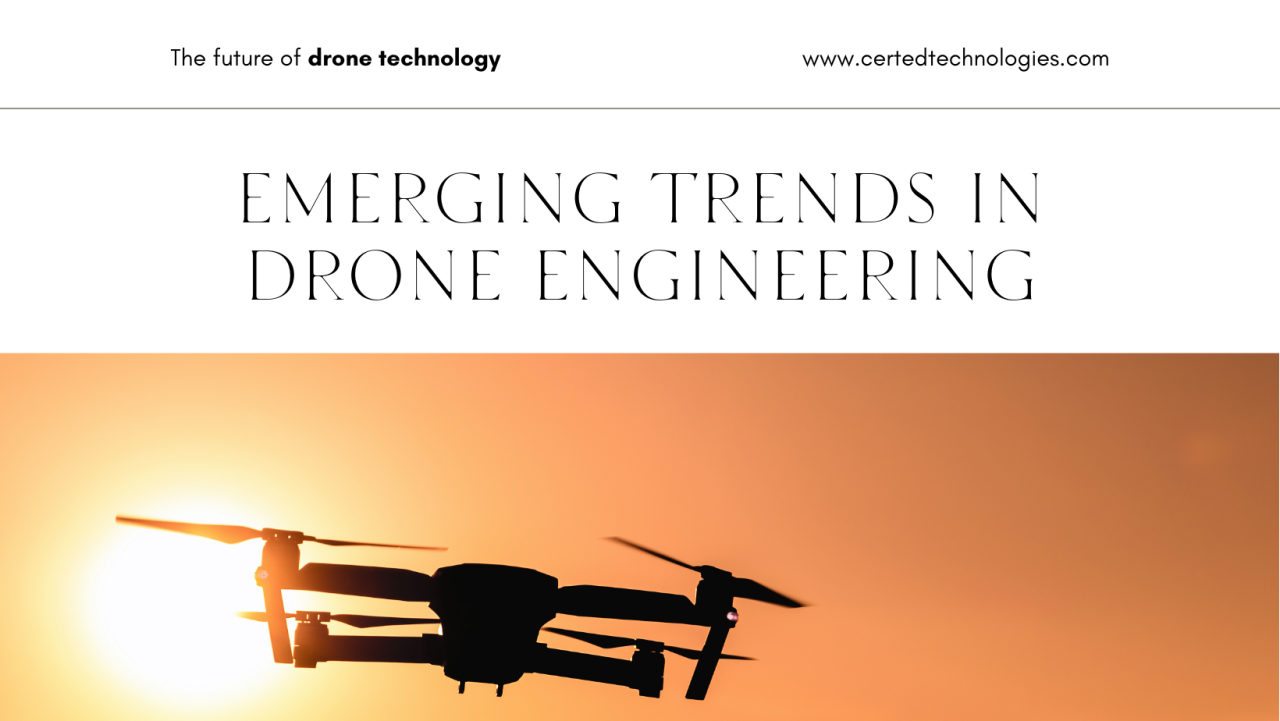Emerging Trends in Drone Engineering: The Future of Drone Technology

In the ever-evolving world of technology, drones have emerged as one of the most revolutionary innovations of the 21st century. From hobbyist devices to critical tools in industries, drones have transcended their initial purpose as remote-controlled gadgets to become indispensable components of modern technology. This transformation is driven by advancements in drone engineering and drone technology, paving the way for a future where drones will play an even more integral role in our daily lives.
This blog explores the latest trends in drone engineering, the industries they are revolutionizing, and the challenges and opportunities they bring.
The Evolution of Drone Engineering
Drone engineering has come a long way since the early unmanned aerial vehicles (UAVs) used primarily for military reconnaissance. Today, drones are equipped with sophisticated technologies such as:
-
AI-powered navigation
-
LiDAR sensors
-
Thermal imaging cameras
-
Advanced communication systems
These innovations combine aerodynamics, robotics, data science, and wireless communication technologies.
The democratization of drone technology has also led to its adoption in industries like agriculture, construction, logistics, and entertainment. Understanding the emerging trends shaping the future of drone engineering is essential for staying ahead in this rapidly growing field.
Emerging Trends in Drone Technology
1. Artificial Intelligence and Machine Learning Integration
AI-powered drones are capable of autonomous navigation, obstacle detection, and real-time decision-making. These features allow drones to execute complex missions without constant human intervention.
Examples:
-
Agriculture: AI-driven drones analyze crop health, detect pests, and optimize irrigation.
-
Delivery Services: Companies like Amazon use AI to enable safe, efficient drone deliveries.
-
Search and Rescue: AI-enabled drones locate survivors in disaster-stricken areas using thermal imaging.
2. Beyond Visual Line of Sight (BVLOS) Operations
Advancements in communication technologies are enabling BVLOS operations for:
-
Long-range inspections of pipelines and power lines.
-
Large-scale agricultural monitoring.
-
Drone-based logistics and deliveries.
3. Swarm Drone Technology
Inspired by insect behavior, swarm drone technology involves multiple drones working collectively to:
-
Monitor disaster-stricken areas.
-
Enhance military reconnaissance.
-
Perform synchronized entertainment tasks, such as light shows.
4. Hybrid Power Systems
To address limited battery life, researchers are developing hybrid power systems using fuel cells and solar power. These systems enable long-duration missions and reduce drones' carbon footprints.
5. 5G Connectivity and IoT Integration
The rollout of 5G networks enables drones to:
-
Share real-time data for smart city applications.
-
Improve precision in industrial inspections.
-
Enhance traffic monitoring and control.
6. Advanced Payload Capabilities
Modern drones are equipped with payloads like:
-
LiDAR sensors for topographical mapping.
-
Thermal cameras for firefighting.
-
Heavy payload systems for logistics.
Industries Revolutionized by Drone Engineering
1. Agriculture
Drones enable precision farming by:
-
Monitoring crop health.
-
Optimizing irrigation systems.
-
Mapping farmland for resource allocation.
2. Construction and Infrastructure
In construction, drones are used for:
-
Site surveys and progress monitoring.
-
Inspecting structures for safety.
-
Creating 3D models for planning.
3. Logistics and Delivery
Drones are redefining logistics by providing fast, cost-effective delivery solutions. "Organizations such as Zipline utilize drones to transport medical supplies to hard-to-reach locations."
4. Public Safety and Disaster Management
Drones assist in:
-
Search and rescue missions.
-
Damage assessment after disasters.
-
Surveillance for law enforcement.
5. Entertainment and Media
Drones revolutionize media through:
-
Aerial shots for movies.
-
Live event coverage.
-
Drone light shows as an eco-friendly alternative to fireworks.
Challenges in Drone Engineering
Despite its rapid growth, drone engineering faces challenges like:
-
Regulatory Hurdles: Varying airspace and privacy laws.
-
Battery Limitations: Short flight durations.
-
Safety and Security Risks: Cybersecurity threats and mid-air collisions.
-
High Initial Costs: Expensive technologies.
Future Opportunities in Drone Engineering
The future holds immense potential:
-
Urban Air Mobility: Passenger drones and air taxis.
-
Environmental Monitoring: Combat climate change and track wildlife.
-
Healthcare: Deliver medical supplies to remote locations.
-
Education and Training: Specialized drone courses to meet demand.
Conclusion
As drone engineering advances, its applications will become more diverse and impactful. With trends like AI integration, swarm technology, and 5G connectivity, the potential of drones is limitless.
For students, professionals, and enthusiasts, this is the perfect time to explore drone technology. By staying updated and acquiring relevant skills, you can become part of this exciting future.
FAQs
1. What is the future of drone technology?
The future includes AI-powered autonomous drones, hybrid power systems, and urban air mobility solutions like passenger drones.
2. How are drones used in agriculture?
Drones monitor crop health, optimize irrigation, and help reduce waste through precision farming.
3. What industries benefit the most from drone technology?
Key industries include agriculture, construction, logistics, public safety, and entertainment.






